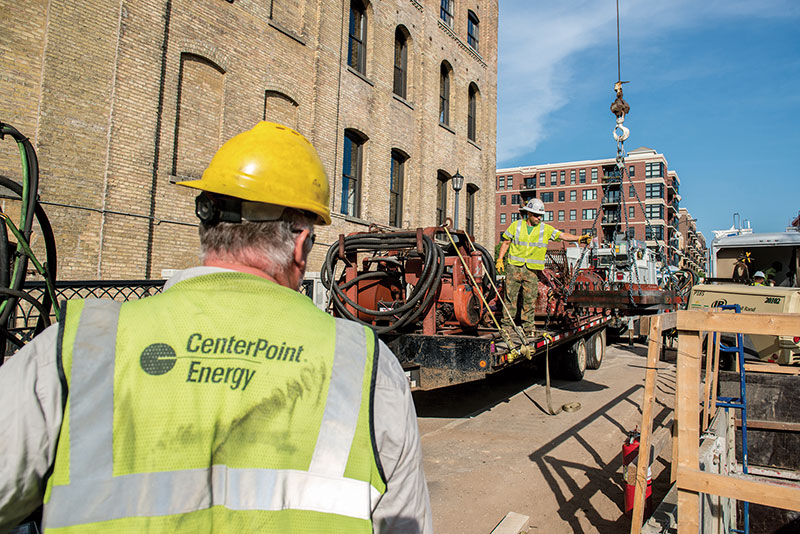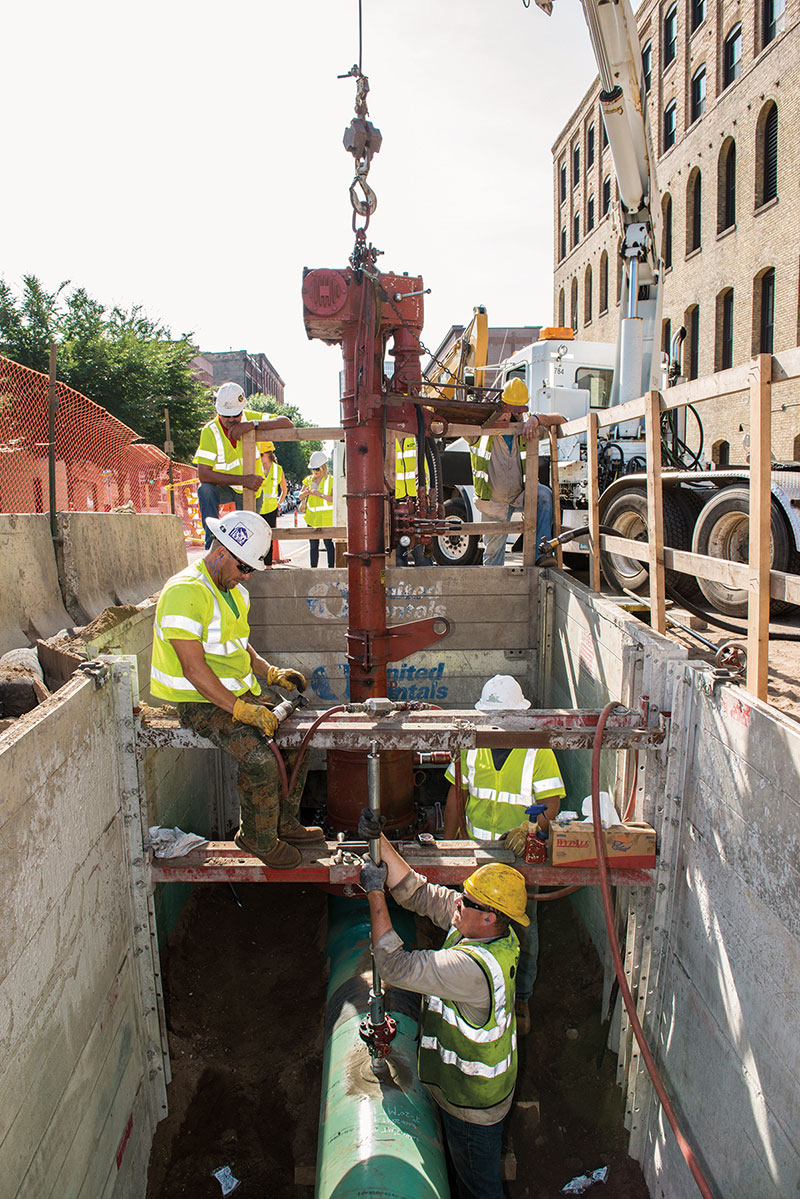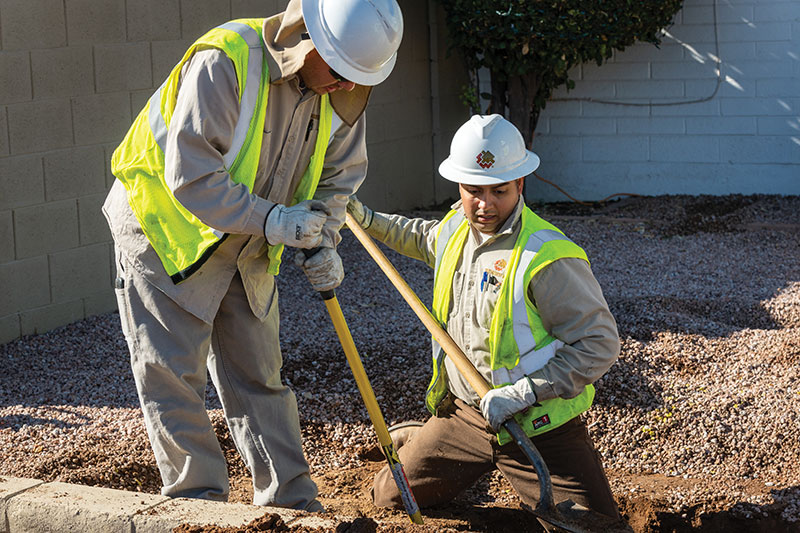November 2020, Vol. 247, No. 11
Features
Beneath the Bustling City, Pipelines Operate Largely Unnoticed
By Danielle C. Roberts, Energy Writer
In St. Louis, the neighborhood of Compton Heights, with its ornate stone and brick homes, dates back to the late 1800s. In busy Minneapolis, the Beltline is a key artery traversed by hundreds of cars every day. One densely populated area in Las Vegas is packed with restaurants, including a popular Mexican eatery readying to celebrate Cinco de Mayo.
All are very different urban settings where gas pipeline construction might take place, each with its own challenges.
Within cities where traffic is never-ending, customers are many and patience often comes at a premium, utilities considering pipeline replacement or expansion have to have it all. Great communication, a solid plan, the latest technology and a smart public awareness strategy are paramount to pipeline construction.
In Minnesota, CenterPoint Energy has the luxury of looking back. In 2017, it replaced all of its cast-iron main in the state and is well on its way to replacing its older steel lines through its 60-mile (97-km) beltline transmission program, which is set to be completed by 2023.
But that luxury comes from looking forward. “We actually look a minimum of five years down the road” for urban projects with a high level of complexity, said Tom Ollinger, the utility’s director of operations.
These complexities could include the following: What public improvement projects do the city, county or state have in the works? What other utility lines are within the area? What are the exact size and pressure of pipe? Where exactly is it, and how deep is it? What are the future growth opportunities in the area? How do we minimize impacts to the neighborhood, such as access? When is traffic heaviest? What about public transit or emergency response needs? Are there any upcoming parades, festivals or other events? Where should meters be placed?
Missouri’s Spire would add other questions to that list. Its pipeline replacement program started about 10 years ago when it began looking at replacing the cast-iron utilization pressure system that encompasses the entire city of St. Louis. Some of the city’s original neighborhoods are nearly 100 years old.
The historic aspect brings up aesthetic considerations to meet neighborhood association requirements, such as additional effort to preserve granite curbs or cobblestone streets and to place meters out of sight.
All of that time, effort and consideration happen ahead of a project to condense actual construction time and to force downtime due to the unexpected to the minimum. “Communication is key, more often and early and often, and it starts with that planning piece,” said Ollinger.
Also essential are regular meetings with key stakeholders, such as city, county and state officials, neighborhood associations, individual customers, other utilities, first responders, crews and contractors, to “ensure all parties understand the job plans and expectations prior to the start of each project,” said Amy Washburn, a public information officer at Southwest Gas.
While the utility’s pipeline system was only developed in the last several decades and is relatively young compared to Midwestern or Eastern systems, she says Southwest Gas works to be consistent in maintaining and replacing pipe in accordance with, or in advance of, pipe replacement guidelines.
“Transparency with all parties involved in each project allows all entities to be part of the solution to any challenge presented while maintaining safe operations at all times,” she said.
CenterPoint starts its planning through SUE, or subservice utility engineering process, which uses a field survey crew to uncover the answers to what exactly is underground to incorporate a high level of detail into the project’s design phase.
“What I’ve found is that the more work I can do up front on paper, the less time is spent in the field,” Ollinger said. “If these things come up and they weren’t planned for or expected, then that’s a lot of downtime you have with resources trying to figure out what contingencies are needed. But, if you get these things worked out on the front end, it makes the project that much more efficient on the back end.”
For its massive St. Louis project, Spire is likewise proceeding in an orderly fashion to minimize impacts to customers. It has deliberately planned to move block by block, neighborhood by neighborhood, working just 300 to 500 feet (91 to 152 meters) at a time, using a risk-based approach.
“It really started off with our system planning group designing this new system. Starting with the header or backbone mains that are needed to carry the larger flow into these areas, smaller mains were installed on the individual streets. Until its completion, the old cast-iron system remained viable during replacement until each section could be retired,” said Rob Atkinson, Spire’s director for field operations for the south region. “A lot of upfront planning was required to do this and maintain our customers.”
Field Innovation
At the same time, Spire keeps its construction design very general – “on purpose,” said Atkinson. “Instead of spending a ton of time and effort on the front end trying to figure out the exact design, which would really take a lot of time and effort, we give the construction crews the latitude to figure out the best way to go from Point A to Point B.”
The crew supervisor is a critical role. He or she coordinates with other agencies and directly with customers to identify solutions to any issues. These could run the gamut from determining how a meter can be placed in a home without tearing up a basement, changing the layout of where a main should be placed or figuring out the best path to run a new service line, instead of just blindly following a preapproved plan.
“It’s really created a lot of innovation in the field for how they go about getting the work done so the customers are satisfied,” said Atkinson.
Any urban setting means getting a job done well, safely and quickly. Directional drilling or boring is one tool used on a case-by-case basis when utilities require a fast and efficient way to install a line and minimize the amount of road impacted from construction, said Ollinger.
CenterPoint also leans on construction standards to help expedite urban construction, such as using a hydrovac machine for excavation. “Instead of just a bunch of backhoes out there digging up and ripping things up, it’s what I call a giant vacuum on wheels, and we’ll literally suction the dirt out,” said Ollinger.
Southwest Gas likewise uses vacuum extraction in certain scenarios, said Washburn, because it allows “crews to get to the pipe faster and it’s safer than using a backhoe or shovel.” Although it is a more expensive alternative, the hydrovac is more efficient than traditional digging methods and can reduce the risk of third-party damage – and the associated downtime – particularly where cable or electric lines are also present.
As part of their environmental, social and governance (ESG) sustainability reporting practices, most, if not all, utilities are also taking a closer look at methane emission prevention. To that point, CenterPoint uses leak repair sleeves for polyethylene pipe to literally wrap over certain leaks caused by third-party damage. They also use a device called a Safe T Stopper that allows workers to remove vintage T connections on mains without having to vent or isolate the gas on that main.
In cases in which gas must be removed for work to be done, CenterPoint – along with other utilities such as Dominion Energy, Con Edison and SoCalGas – uses the ZEVAC (Zero Emissions Vacuum and Compression) device to capture and return natural gas into the system, instead of venting into the atmosphere. For the utility, the tool is part of a suite of processes and technology to help it meet a goal to reduce operational carbon emissions by 70% by 2035 (from 2005 levels).
To help improve operational effectiveness, Spire has also made a move to use larger-diameter plastic pipe – up to 12 inches (305 mm) currently – relying on fusion-based connections instead of mechanical fittings. “It’s all solid pipe, just fused together,” said Atkinson. “We think that’s the best long-term strategy for saving on maintenance.”
Meanwhile, CenterPoint is one of a handful of utilities with its own in-house materials and research lab to test pipeline and other infrastructure equipment and verify that it meets industry standards and its own rigorous quality standards, said Ollinger. That’s part of the reason the utility has also moved to a 12-inch-diameter polyethylene plastic pipe; it helps eliminate corrosion concerns and increases the life expectancy of the pipe.
Southwest Gas also engages in new infrastructure equipment testing through its own dedicated lab. “We also participate in research consortiums like Gas Technology Institute (GTI) and NYSEARCH that research new equipment for gas utilities,” said Washburn.
Customer Satisfaction
Still, no matter how highly technical or how well planned a project, it could arguably be called a failure if customers flood a call center with complaints.
“Our President and CEO Suzanne Sitherwood challenged us a couple years ago to look at this impact and understand the balance between the quantitative productivity of getting this pipe replaced and the quality of our construction,” said Atkinson. “We’re currently implementing a construction quality initiative to measure the impact of our construction on our customers and our communities and the city itself.”
The initiative will examine ways to increase communication with customers through avenues such as neighborhood associations or city aldermen before, during and after construction. It will conduct post-construction consumer surveys to assess how crews performed. It will track excavations and the timelines on when holes are closed.
It will also hold site evaluations to identify where crews are successful in maintaining good practices and minimizing neighborhood impacts. Finally, it will track resolutions to customer complaints and claims on each project.
“This is a huge initiative for us,” he added. “We want to make sure we’re not just doing well getting the pipe in the ground but are doing it in a way that impacts our customers the least as far as being invasive.”
Like many utilities, CenterPoint has dedicated some of its communication team to handling announcements of projects. However, it moved to having a full-time communications specialist just for its construction projects last year.
That team member is responsible for mailing letters in advance to customers affected by a project and hosting open houses and informational meetings. He or she also connects with neighborhood associations, business groups and elected officials.
During construction, that person sends email and text message updates to stakeholders, along with posting web updates. On the construction side, project heads notify the communication specialist about any issues so that he or she is able to get ahead of them, coordinate with customers and, ideally, preempt a flood of unhappy callers.
Meanwhile, at Southwest Gas, it uses a scalable construction outreach program that ensures it can proactively communicate with impacted stakeholders before a project begins and keep them informed throughout its duration, said Washburn.
Along with its online interactive map detailing construction projects, “outreach ranges from face-to-face, canvasing a small community, to large digital advertising outreach campaigns, targeting those who drive through a highly traveled area within the project area,” she said.
Pandemic Considerations
This year, COVID-19 threw another wrench into an already complicated process. But utilities quickly developed protocols to assure crew and contractor safety while on the job. Southwest Gas, for example, has continued its full schedule of replacement and expansion projects.
“Many of our service territories are in the fastest growing regions of the country, where growth has not diminished during the pandemic,” said Washburn. “Further, we continue to expand our gas service in Mesquite, Nev., and expect to expand into Spring Creek, Nev., by the end of the year.”
With less traffic and fewer commutes due to COVID-19 restrictions, CenterPoint found that cities and counties “opened up the flood gates on their public improvement-type programs,” said Ollinger, to “take advantage of the lack of road traffic on the streets. That actually increased the amount of work we had.”
In-house meter replacements or installations were a different story. Spire, for example, had two months’ worth of backlogged meter upgrades – several hundred total – once safety protocols were worked out and the utility started sending workers back into customers’ homes.
Protocols for workers include N95 respirators for workers, gloves, eye protection and booties, or a full environmental suit in those cases when a customer has or had COVID-19. By ramping up its processes, Spire was able to reduce the backlog; it also invested in an asset management system several years ago that allowed it to successfully track its backlog and adapt quickly once the pandemic hit. As of the end of August, it was back on schedule.
Challenge, Opportunity
The year 2021 will mark a decade since the U.S. Department of Transportation and the Pipeline and Hazardous Materials Safety Administration issued a call to action to speed the repair, rehabilitation and replacement of pipeline infrastructure at highest risk due to age or material type. It’s a challenge – but also an opportunity.
“Because many of our service areas are in parts of the country that continue to see immense growth, we know the public can grow tired and frustrated by constant construction and roadway work needed to accommodate such expansion,” said Washburn. But she said the utility uses its projects to “educate the public about the importance and strengths of natural gas.”
Urban or otherwise, Spire’s Atkinson agrees. He urges other utilities to “not just think about how you’re going to do this work but why and how it impacts the customers, and be out front with that, communicate with them and get their feedback on how you can meet their needs beyond just doing the work to get the replacements done.
“That’s really been an eye-opener for me.”








Comments